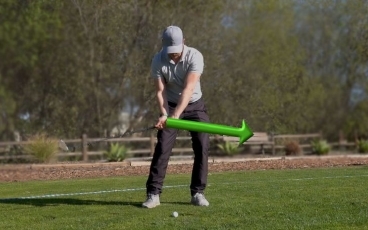DOWN = UP
We have all heard that golf is a game of opposites – and this is true in many respects.
However, it is a myth that hitting down on the ball causes the ball to go up.
The angle of attack (whether the club is moving up, down or level with the ground at impact) has very little to do with the launch of the ball.
Take, for example, the following two scenarios.
In both images, the dynamic loft (loft at impact) of the club remains the same. However,
- In picture A, the club is moving upwards
- In picture B, the club is moving downwards (hitting more down)
Yet, the ball launches up in both scenarios, disproving the idea that you have to hit down to get the ball to go up.
This is because the dynamic loft of the club is far more influential than the angle of attack regarding the launch of the ball. So, whether you hit down or up is largely irrelevant to the launch of the ball – it’s more a product of how much loft you are presenting at impact.
WHY HIT DOWN ON THE GOLF BALL?
So how and why did this phrase spread?
Well, although hitting up on the ball and hitting down on the ball both work to get the ball in the air, we cannot actually hit up on a golf ball if it is resting on the ground – because the ground is in the way.
NOTE – it is possible to have a slightly ascending blow on the ball when it is resting on the turf, but a fluffy lie is required – and this is not the tour-player’s preferred method.
Also, with a ball on a tee, we are able to hit up on it as we have more distance between the ground and the ball. In fact, hitting up with a driver is beneficial for maximizing distance.
Trying to hit up on the ball when it lays on the ground is one of the biggest conceptual misunderstandings that the average/beginning golfer has. This concept alone can cause some seriously poor strikes and inconsistenciesin one’s game.
In order to achieve the pro-like ball-then-turf strike, the clubhead needs to be moving down at impact.
We would say we are hitting on the downward part of the swing arc.
WHY NOT TO HIT DOWN ON THE GOLF BALL?
So, what’s all this fuss about? If getting the clubhead to move down at impact is what the pros do (with shots from the turf), why is the article titled “why you shouldn’t hit down on the golf ball”?
Take a look at the following picture of Tiger Woods at impact.
Notice the blur of his hands. Notice how they are moving UP through impact.
When you ask a golfer to hit down on the ball, they will often respond by trying to force the hands downwardsthrough impact. Doing this can
- Slow the club speed (as we reduce parametric acceleration)
- Reduce our ability to square the clubface up – creating directional inconsistency
- Reduce the width of the clubhead arc – creating strike inconsistency
- Create less consistency with the swing path
- Reduce our ability to release the club, causing a low launch and reducing the bounce of the club
- Create a smaller margin for error regarding ground strike
MAN DOWN
Another big thing with “hitting down” is that it can cause a player to dive their body towards the ground through impact.
Not only does this spoil what we call the kinematic sequence (the order of which our body parts fire), but it can ruin our ability to create speed.
When our center of mass (our body) accelerates towards the ground through impact, we lose the ability to create ground pressure. When we lose ground pressure, we lose the ability to rotate our body quickly.
Think about trying to punch someone really hard while floating in space (where there is no ground pressure) versus standing on terra-firma.
SO, WHAT SHOULD WE DO?
First, understand that hitting up or down is not the main reason for why a golf ball goes up –loft is the biggest influence.
Next, we need to learn how to get the clubhead to descend on the ball while the hands work up (actually, it’s a 3D thing where the hands work away from the ball through impact).
And yes, the club can descend on the ball as the hands work up (see below picture of Tiger Woods)
The yellow line shows the path of the top of the glove. The white line shows the clubhead movement.
Doing this can give us the benefits of increased speed and consistency (directionally and with our strikes).
I show you how to do this in the shallowing module of The Strike Plan. Strike Plan members can CLICK HERE (MEMBERS ONLY) to access this module.








